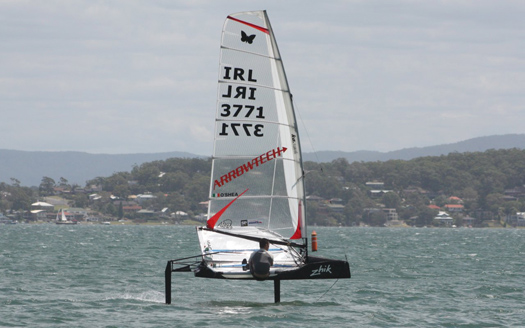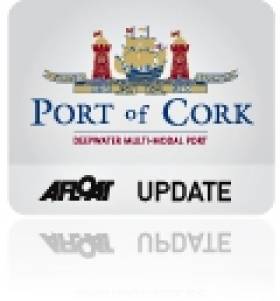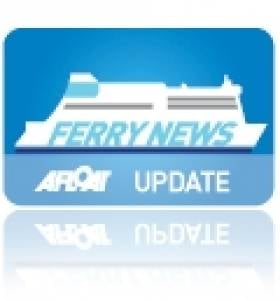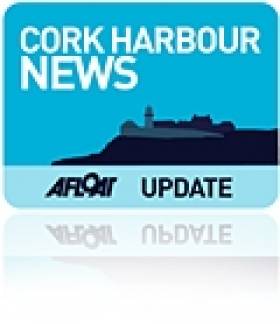Displaying items by tag: Cork Harbour News
Vacancies at Mainport International Corporation
The Mainport International Corporation has vacancies for the following positions.
Masters for their Seismic Support Vessels working worldwide. The suitable candidate is required to have good ship-handling experience, as the position involves replenishment of seismic vessels at sea, while underway. Simulation training will be given at the National Maritime College of Ireland (NMCI) Ringaskiddy prior to commencement of employment.
In addition there are vacancies for Engineers on board their Seismic Support Vessels. The position is for a tour of duty of two-months on and two- months off. Applicants are asked to email their CV and relevant certificates to [email protected] and [email protected]
For further information in general about the Cork based Mainport Group logon to www.mainport.ie and for the NMCI www.nmci.ie
Passing of Irish Naval Service Officer Commander
Following his retirement in September 1980 he worked with Irish Shipping Ltd for a further five years during the construction of the state-owned company ships at the Verolme Cork Dockyard. At the same dockyard, he had also been closely involved in the design and commissioning of the Naval Service's helicopter patrol vessel L.É. Eithne, its largest vessel which was built in 1984.
To read more about the distinguished career of Cdr Liam Ahern and also his wartime role in the Royal Navy, his obituary is published in today's Irish Times.
Jehan Ashmore adds that the L.É. Eithne arrived into Dublin Port this morning to dock at Sir John Rogersons Quay next to the French Navy minehunter Cassiopée (M642) and mine-route survey craft Altaïr, which have been on a visit to the capital for the St. Patrick's festivities.
At 1,760 tonnes the L.É. Eithne is not only the largest vessel of Ireland's eight-strong fleet but is also the last ship of any type built in the Republic of Ireland. For a photo of the 27-year-old ship seen off Cobh (where Cdr Ahern was born) click here.
The 80m vessel has a crew of 85 (9 Officers and 77 ratings). Her main armament is a Bofors 57mm anti-aircraft gun with a LIOD fire control system and two 20mm Rheinmetals.
In 1986 L.É. Eithne made a historic visit as the first Irish Naval Service ship to cross the Atlantic, where she sailed to the United States, visiting Hamilton, New York and Boston. A decade later she became the first Irish Naval ship to tour the continent of South America.
Anniversary Sailing Bound for the Rugby
West Cork Tourism Co-Op launched the company a year ago as a result of a successful campaign to restore the direct service between Wales and the southern Ireland. Many businesses from the region and their Welsh counterparts invested in the co-op to restore the link since the closure by Swansea Cork Ferries in 2006.
Fastnet Line will continue to be in a celebratory mode with the first outbound sailing from Cork on Friday and which will also cater for a special-rugby supporters trip for this weekend's Six Nations Championship between Ireland and Wales at the Millenium Stadium, Cardiff. The Friday sailing departs Cork at 20.30hrs and arrives at 08.00hrs in Swansea on the Saturday morning with the game kicking off at 17.00hrs (5pm).
The company are offering various foot passenger deals to the match. A return bus transfer is also available between the ferry terminal and the game venue (but at an extra cost). In addition there are deals for those wanting to take the car. The after match sailing departs at 23.50 with the ferry arriving back in Cork at 12.00 noon on Sunday 13 March. For further information on fares etc click here
Officer Cadetships in the Naval Service
The positions are Army Officers, Air Corps Officers (Pilot) and Naval Service Officers (Operations Officer or Engineering Officer). For further information including salary scale logon to www.military.ie/careers/officer
Applications for the 2011 Officer Cadet Competition are only being accepted online at www.military.ie and only from candidates who meet the minimum eligibility qualifications. Noting the closing date is 20 March 2011.
Professional Short Courses at NMCI
Personal Safety & Social Responsibility (PSSR) - May 16th 2011
Advanced Fire Fighting (5 days) – Apr 11th 2011
Personal Survival Techniques (PST) Mar 22nd & Apr 26th 2011
Elementary First Aid May 23rd 2011
Efficient Deck Hand – May 30th 2011
Team Building (on demand)
Water Safety Course (on demand)
In addition listed below are the following OPITO Approved Offshore Courses.
BOSIET 3days - Mar 9th, Mar 28th 2011
MIST 2 days - Mar 3rd ,Mar 7th, Mar 31st 2011
FOET 1 day - Mar 14th ,Mar 23rd 2011
HUET & EBS - On demand
For more details on these courses contact the NMCI on (021) 497 0600 click HERE and in general information about the maritime college www.nmci.ie In addition there are further details about the oil and gas sector by clicking on this website www.opito.com
Former WW II Oil-Tanker Lays Cables Across Cork Harbour
To read further information about the cable installation project which is listed on the Port of Cork Company website under Notice to Mariners (No. 6 of 2011) click here.
The odd appearance of the barge masks a colourful and chequered career, as only a remnant of the original vessel survives (see photo). Only the forward section and bow (90m long X 20m beam) remain after the partial scrapping of the former oil tanker, Esso København, which took place nearly fifty years ago.
She was launched in 1930 as the MS Peter Hurll by the Palmers Shipbuilding and Iron Company Ltd (Yard/Hull no. 479) at Hebburn-on-Tyne, England. Measuring 11,952grt the tanker was commissioned for Baltisch-Amerik Petroleum Import G.m.b.H. (Waried Tankschiff Rhed.) of Danzig. For further details click here.
The vessel's profile was typical of the era, with a 'two-island' arrangement where the bridge superstructure is sited amidships and separated from the crew's accommodation quarters located aft on the poop deck at the stern.
At 452-foot long, the 17,585dwt vessel had a cargo carrying capacity of 138,108 barrels, which had an assigned pumping rate of 4,000 barrels an hour. The twin-screw diesel powered vessel had 5,300 brake horsepower engines that gave a speed of 12.3 knots.
In 1935 the vessel was sold to the Panama Transport Co. of Panama. While en route to Aruba, with an American crew, war was declared in Europe on September 3, 1939. At the Caribbean island's port of Las Piedras the Peter Hurll loaded her first war-time cargo of 106,514 barrels of fuel and crude oils bound for Everett, Mass.
Throughout the war years the Peter Hurll was crewed at various times between Americans and Danes. To read in greater detail the career history of the vessel and an account of the attempted U-Boat attack on the Peter Hurll click here. The tanker had several sisters, the F. H. Bedford Jr, J. H. Senior, J.A. Mowinckel and The Heinrich v. Riedemann which was lost on April 16, 1942.
Only a few months after the war in February 1946, the Peter Hurll bunkered the Queen Mary, which was moored alongside Pier 90 on the North River, New York. In less than 10 hours the vessel tranferred 27,797 barrels of fuel in a direct tanker-to-ship delivery of fuel oil. The famous 80,000 tonnes Cunard liner which like the tanker, was also built in 1930, had been recently re-converted from a troopship to her peacetime role as a passenger-liner.
In 1967 the liner retired and the vessel is moored at Long Beach, California, as a static hotel, restaurant and museum (see www.queenmary.com).
Two years later the Peter Hurll changed ownership to Det Danske Petroleums A/S of Copenhagen but later under the control of Dansk Esso A/S was renamed Esso København (see link) and the vessel was enlarged to a tonnage of 12,043grt.
In 1952, the vessel was taken to Odense, Denmark by H. J. Hansen, where the vessel was partially broken-up. The remaining fore-end survived and was rebuilt as a cable / pipe laying barge in 1963 (click here). The structure which essentially is a barge was named Henry P Lading for new owners, Nordisk Kabel og Traadfabrikker A/S, Copenhagen.
At one stage the barge was renamed "Nkt Cables a/S" but in 2002 the barge was sold to Jydsk Dykkerfirma ApS, now named JD Contractor A/S. The company (click here) is the largest underwater contractor in Denmark, providing diving assignments and the laying and embedding of submarine cables and pipelines worldwide.
Only late last year, scuba-divers found a fully intact World War I U-Boat on the seabed just outside Cork harbour. To read more about the U-Boat which sank some 93 years ago and photos click here.
Amendments to Pilotage Byelaws
For further information about this and to download a copy of the Pilotage Byelaws click this link. In addition the port company has a draft copy of the Pilotage Byelaws which is available for collection from:
The Port of Cork Company, Custom House, Custom House Street, Cork
The port can be contacted by Tel: 021 4273125 and for other genaral information on the port logon to www.portofcork.ie
‘Proposed’ Cork-Spain Route Remains Under Review
In addition to services running out of Rosslare operated by Celtic Link Ferries and Irish Ferries and the alternative option of landbridge connections to Europe via the UK.
In the meantime, the Port of Cork will continue to be in dialogue with potential operators and investor's, however in the current climate it is proving more challenging to establish the service. Yet both the port authorities in Cork and Gijon remain committed in establishing the first direct Irish-Iberia passenger ferry route, with an update on the Spanish service due in early June.
Since 2008 the port authorities of Cork and Gijón, through the Promotion of Short Sea Shipping and Co-Operation with Small Medium Enterprise's (Proppose) an EU Inter-Reg project, have conducted feasibility studies into the service.
Interest in the service to date, has shown interest from Brittany Ferries, P&O Ferries and Transfennica, a Scandinavian based operator. It was envisaged that a ro-pax type of vessel would operate the 24-hour route to Gijón in Asturias, the region which forms part of Spain's northern 'Green' coast.
The route across the Bay of Biscay would be an attraction to freight hauliers, saving mileage and reduced fuel costs in addition avoiding a weekend ban to trucks travelling through France.
Last summer the ro-pax Norman Bridge started a new route between Nantes / St. Nazaire (Montoir-de-Bretagne) and Gijón, operated by GLD Atlantique. This route received support through the EU 'Motorways of the Seas' (MOS) programme to divert vehicle traffic from congested road-infrastructure and transferred to designated shipping routes, using larger and faster ro-pax vessels.
The route's opening was marked with a declaration signed by Dominique Bussereau, the French Minister of State responsible for Transport and his Spanish counterpart Magdalena Alvarez of the first of two Franco-Spanish MOS concept routes, starting with the 14-hour GLD Atlantique service.
- Irish Ferries
- port of Cork
- Celtic Link Ferries
- Fastnet Line
- P&O Ferries
- Brittany Ferries
- Ports and Shipping News
- Cork Harbour News
- RoPax
- Port of Gijón
- Proppose
- Motorways of the Seas
- MOS
- Transfennica
- CorkGijón
- Asturias
- 'Green'Spain
- Landbridge
- NantesSt.Nazaire
- GLD Atlantique
- Norman Bridge
- Cork Harbour
Amendment to Fastnet Line Ferry Schedule
Reservations Office Ireland : +353 (0) 21 4378892
Open Monday - Friday 9.00 am - 5.30 pm
Reservations Office UK: 0844 576 8831
Open Monday - Thursday 8.00 am - 8.00 pm
Open Friday 8.00 am - 7.00 pm
Open Saturday and Sunday 9.00 am - 6.00pm
O'Shea Fourth in Moth Worlds Silver Fleet
Ex-Pat Michael O'Shea has finished fourth in the silver fleet of the Moth world championships staged in Belmont, Australia.
The class promises to be the next hot thing because of its high speed through the use of foils that keep the hull clear of the water. The class has yet to be established in Ireland.
The Cork sailor set a personal best of 27.5 knots (10 second average) in one of the races.
O'Shea, a former 49er and Hobie 18 sailor from Monkstown, is now living in Sydney and was the sole Irish competitor at the Moth event.

Michael has heard that heard there are a couple of boats in Dublin and is keen to help out anyone who is looking to get into the class with tips and tricks.
Watch the interview with Michael below. More pics of Michael HERE.
His next target on water is to try and hit 30 knots, not bad in a sailing dinghy! but his target ashore is to spread the word of these great advances back home.
"I'm looking to see if I can promote the class in Ireland and get some other sailors interested. The next worlds (2012) are in Lake Garda, somewhat easier to get to fro Ireland, he told Afloat.ie.
And it appears the boats are easily transportable- thanks to Ryanair - click HERE






































































